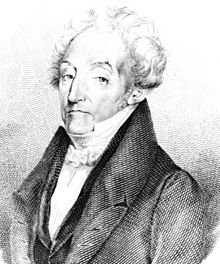Giovanni Rasori
Giovanni Rasori (born August 20, 1766 in Parma , † April 12, 1837 in Milan ) was an Italian doctor .
Live and act
Rasori was the son of the director of the hospital pharmacy of Parma . He began his studies at the university of that city and aroused the interest of the Duke of Parma Ferdinand of Bourbon . This enabled him to study three years in Florence with Felice Fontana , two years in Pavia and finally two years (1793–1795) in England a. a. to continue with the surgeon John Hunter . Rasori was fascinated by the Enlightenment climate and the pre-revolutionary era . In 1795 he settled in Milan . In 1796 he was appointed Dean of the University of Pavia and Professor of Pathology in Antonio Scarpa's position .
In the Cisalpine Republic in 1797 Rasori became secretary to the interior minister Tadini in Milan . In 1799 in the Second Coalition War , he left the city with the French and returned in 1801 after the Battle of Marengo . He became chief physician at the military hospital and taught medical clinic at the Ospedale Maggiore from 1806 to 1814 . Because of his involvement in a conspiracy against the Austrians, he lost his position in 1814 and was imprisoned until 1818. After his release, he only worked as a doctor.
Contrastimulus
Rasori first adopted the arousal theory of the Scottish doctor John Brown (1735–1788), which defined every disease as either "sthenia", ie overstimulation, or "asthenia", the inability to react to stimuli. Accordingly, therapy has been reduced to the use of stimulants and depressants.
During a severe typhus epidemic in Genoa in 1799, Rasori Brown's theory was able to apply in practice on a large scale. However, he was disappointed with the results and expanded Brown's system by giving the state of "sthenia" the name "diathesis di stimulo" and the state of "asthenia" the name "diathesis di contrastimulo". Which condition is involved can only be decided by the action of the remedy. His preferred means of testing was bloodletting , which he used often and abundantly.
Works (selection)
- John Brown: Elementa medicinae. (Edinburgh 1780) Pavia 1792 (in Italian).
- Storia della febbre epidemica di Genova negli anni 1799 e 1800. Pirotta e Maspero, Milan 1801 (anno IX) (German Vienna 1803; French Paris 1822) (digitized version)
- Opusculi di medicina clinica . Volumes I and II, G. Pirotta, Milan 1830 (digitized version )
- Theory de la phlogose de J. Rasori, traduite de l'Italien par Sirus Pirondi . Baillière, Paris 1839. Volume I (digitized version) Volume II (digitized version)
- Principii nuovi di terapeutica. Opera postuma . Volume I and II. Ducale, Parma 1842 (digitized version)
literature
- Josef Bauer. History of bloodletting. Munich 1870, pp. 207–211: The doctrine of contrast stimulus (digitized version)
- Julius Pagel . Rasori, Giovanni R. In: Biographical lexicon of the outstanding doctors of all times and peoples. Urban & Schwarzenberg, Vienna and Leipzig 1886, Volume IV, pp. 672–673 (digitized version )
- Giorgio Cosmacini: Il medico giacobino. La vita ei tempi di Giovanni Rasori. Laterza, Rome 2002.
- Rainer Brömer: Rasori, Giovanni. In: Werner E. Gerabek , Bernhard D. Haage, Gundolf Keil , Wolfgang Wegner (eds.): Enzyklopädie Medizingeschichte. De Gruyter, Berlin / New York 2005, ISBN 3-11-015714-4 , p. 1214.
Individual evidence
- ↑ Josef Bauer. History of bloodletting. Munich 1870, pp. 202–207 John Brown and his influence (digitized version)
- ↑ Josef Bauer. History of bloodletting. Munich 1870, pp. 207–211: The doctrine of contrast stimulus (digitized version)
Web links
| personal data | |
|---|---|
| SURNAME | Rasori, Giovanni |
| BRIEF DESCRIPTION | Italian doctor |
| DATE OF BIRTH | August 20, 1766 |
| PLACE OF BIRTH | Parma |
| DATE OF DEATH | April 12, 1837 |
| Place of death | Milan |
